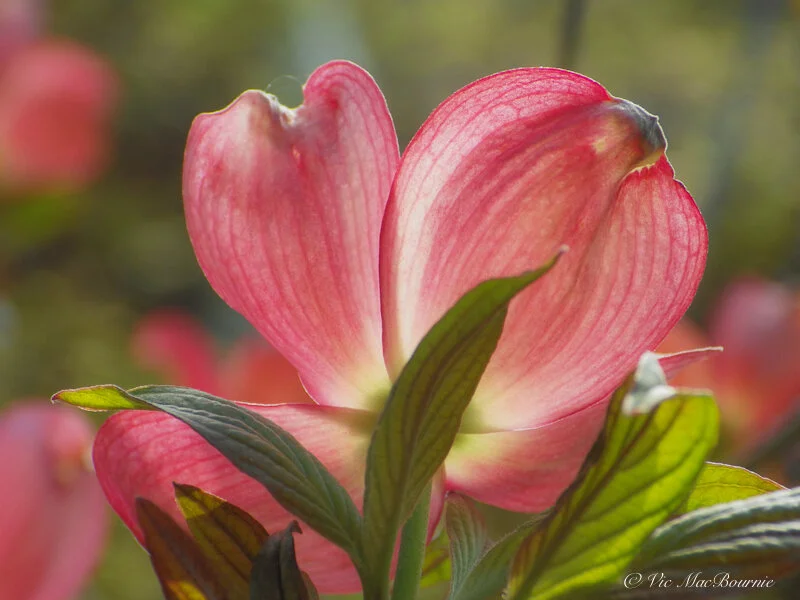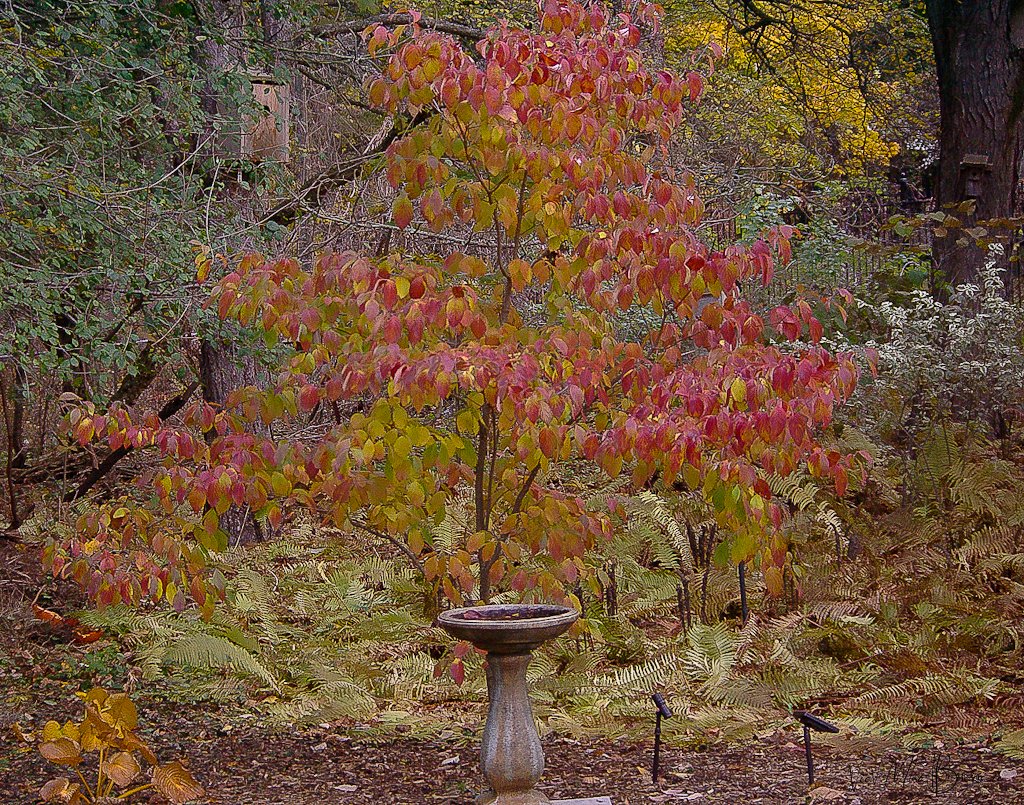Six Dogwoods for the Woodland Garden
Ground covers, small shrubs and trees for everyone’s taste
If you’ve been following this blog, you’ll know that I have a soft spot for Dogwoods – big and small.
I consider them to be the perfect genus providing everything from the perfect ground cover for shade, to shrubs and mid-size trees that create an anchor for the understory layer. Add to this, outstanding spring flowering followed by a profusion of berries that birds, butterflies, native bees, chipmunks, squirrels and a host of other mammals can’t get enough of, and you’ve got yourself the perfect group of plants for the woodland/shade garden.
Oh, and throw in some spectacular fall foliage just to round out the reasons every garden needs to have plenty of Dogwoods.
Buying plants from local nurseries is the common method of obtaining these plants, but be aware that many of Dogwoods have been cultivated and may not provide all the benefits that the straight species provide to our native wildlife.
This flowering dogwood shows off its splendid fall colours in the back garden.
This article should help provide readers with a better understanding of the various dogwoods available. Most of the links in the article will take you to more extensive posts I have written about the individual plants, trees and shrubs.
It’s always best to use a native variety which are more beneficial to local birds, insects and pollinators.
Our Woodland garden boast six varieties of Dogwood. Let’s start with the smallest.
This detailed native dogwood poster is best viewed on a tablet or desktop and was created by Justin Lewis
Cornus Canadensis: A native ground cover for a shady area
Often called Bunchberry (link to my story on this native ground cover) or creeping dogwood, this perennial creeping rhizomatous ground cover grows 3-6 inches high and is topped by a blossom that looks very much like a miniature version of the familiar Dogwood tree (Cornus Florida) blossom. The flower cluster, held on a short stalk just above the leaves, resembles a singe large flower.
Not unlike the tree form of Dogwood, the flower is followed in the fall by a cluster of bright red berries surrounded by wine-red foliage.
More of my posts on Dogwoods
For more information on Dogwoods, please check out my other posts listed here:
Dogwoods: Find the perfect one for your yard
Flowering Dogwood: Queen of the Woodland garden
Cornus Kousa: Impressive non-native for the woodland garden
Bunchberry: The ideal native ground cover
Bunchberry in bloom in the woodland garden.
It grows in sun, part shade to full shade in zones 2-6 and likes to grow in a cool, damp acidic soil. It will often form clonal colonies under pine trees. Amending the soil using peat moss and mulching with pine needles yearly is a good idea if you plan to grow this ground cover.
Bunchberry can be found growing wild in coniferous and mixed woods, cedar swamps and damp areas across North America to Greenland and northeast Eurasia.
Although it can be hard to find at most regular nurseries, higher-end nurseries in the growing zones will either carry it or can often obtain it for you.
Ontario Native Plants now carries the plant in limited quantities so put in your order early to ensure you can get some. If you are in Ontario, be sure to check out my full story on Ontario Native Plants.
This is a new addition to our Woodland garden. I earlier experimented with it in three very different spots in the garden, but all three plants failed. I now have several plants growing on the side of our property in an area where they should thrive.
The Pagoda Dogwood in bloom with its creamy white flowers that are followed with an abundance of berries that birds and other wildlife love.
Cornus Alternifolia: Perfect small tree for the woodland/wildlife garden
This common under story species that is often called Pagoda Dogwood (Link to my full story) is the tree/shrub that got me started down the Dogwood trail. We planted one at our former home right outside the office window and I absolutely loved that small tree. It was also the first tree we bought when we moved to our current home 23 years ago. That tree has become known as our “Africa tree” because of its flat-topped appearance and the fact the deer have eaten it so perfectly from the bottom up.
The tree’s attractive horizontal branching habit creates a lovely tiered look as it ages. Large clusters of cream flowers appear in spring or early summer (very unlike the familiar Cornus Florida bracts) followed by dark blue-black berries by mid summer. What’s not to love?
It grows to about 20-30 ft tall high, preferring moist soils in partial shade. Unlike other native dogwoods, this species has alternate rather than opposite leaves, hence its name. They grow naturally in rich, deciduous and mixed woods, in zones 4-8 often found on forest edges, along streams and on swamp borders.
The bracts of the Cornus Florida Dogwood are beautiful even from below.
Cornus Florida: Crown jewel of the Carolinian forest
In my opinion, the Flowering Dogwood (link to my post on best Carolinian under story trees) is the queen of the under story trees in a Carolinian Woodland setting.
Here is a link to my full story on the Flowering Dogwood or Cornus Florida.
The horizontal branching of the Cornus Florida shows off its spring bracts above the blue jay.
When it comes to the perfect tree, it’s a tough one to beat. Its spectacular in spring flower but still stunning when not in flower. Cornus Florida grows to about 20-40 ft as a single or multi-trunked tree with outstanding showy, white and pink spring blooms, with a horizontal branching habit, red fruit and scarlet autumn foliage.
The flowers, which are actually bracts, can grow to 3 inches wide and attract butterflies and bees. The fast-growing trees prefer partial shade but can tolerate full sun if they are kept moist. They are native to the eastern United States and the Carolinian Canada Forest in southern Ontario and throughout zones 5 through 9. Although they may seem like the perfect tree, they are subject to anthracnose – a fungal disease that causes leaf spotting and twig dieback. Diseased twigs and branches should be pruned off and disposed. Ensuring good air circulation to keep the foliage dry and maintaining moisture in the soil throughout the summer will help reduce exposure to the fungal disease.
The bright red fruit of the Cornus Kousa.
Cornus Kousa: Popular non-native with spectacular summer show
A close second to the native Cornus Florida is the Kousa dogwood, which also goes by the names of the Chinese, Korean and Japanese dogwood. One of the advantages this tree offers over Cornus Florida is the fact it is resistant to the common dogwood anthracnose disease. As a result, it is being used more and more as an ornamental tree in areas where the disease is common.
The Kousa dogwood is a plant native to East Asia but is widely available where the Florida Dogwoods grow. It’s upright habit, later-flowering (about a month later) and pointed rather than rounded flower bracts makes it an ideal companion to the Flowering Dogwood.
Be sure to check out my full story to get much more detailed information on the Cornus Kousa Dogwood.
Although it can be incredibly showy in its own right, the Kousa dogwood tends to flower after the leaves come out rather than the Florida Dogwood that blooms prior to the tree leafing out, Combine both trees in your understory and you have glorious Dogwood flowers from late spring well into summer. Both species have a number of cultivars that include variegated leaves that add to their showiness in the right situations.
Cornus Mas: Early yellow-flowering tree for the shade
Often referred to as the Cornelian-cherry dogwood, this family of dogwood is native to Southern Europe and Southwestern Asia. It can be grown as a small tree or medium to large deciduous shrub with small yellow flowers produced in clusters along the branches either in late winter or more likely early spring in North America.
Here is a link to my full story on Growing Cornus Mas in the woodland.
The fruit has many uses including as an herb and is used widely for jams and and in some European countries distilled to make vodka. In the Woodland, the large oblong red fruit is a favourite of many birds and mammals.
In my garden, the Cornus Mas is one of the earliest flowering trees that blooms alongside the forsythia. I suspect many people mistake the small tree for a forsythia bush.
In our garden, we have a variegated form that grows up through our large ostrich ferns, and provides a spot of colour is a sea of green. The Cornus Mas in our garden is a small tree/shrub and is one of the few variegated plants in our entire Woodland garden.
Cornus sericea: Popular red-twigged shrub ideal for winter interest
Commonly named the Red-osier Dogwood, it is probably one off the most common shrubs in garden landscapes providing much-needed winter interest for gardens, especially when planted in large clumps. Often mistaken for the popular Asian equivalent Cornus Alba, with its variegated leaves which is seen in gardens everywhere.
Cornus sericea is native throughout parts of North America from Alaska east to Newfoundland.
In the wild, it most often grows in dense thickets in very moist areas. Our native species have dark green leaves that turn bright red to purple in fall. The spring flowers are creamy clusters and the fruit are a cluster of small white berries.
These Dogwoods not only look good, the native varieties provide multiple sources of food for backyard birds. While I get great enjoyment from my bird feeding stations, providing natural food sources to our feathered friends is always the goal we should aspire to in our gardens.
I have written a comprehensive post on feeding birds naturally. You can read about it here.
If you are interested in exploring Dogwoods further, check out Dogwoods: The Genus Cornus. This is another outstanding gardening book from Timber press.
More links to my articles on native plants
Why picking native wildflowers is wrong
Serviceberry the perfect native tree for the garden
The Mayapple: Native plant worth exploring
Three spring native wildflowers for the garden
A western source for native plants
Native plants source in Ontario
The Eastern columbine native plant for spring
Three native understory trees for Carolinian zone gardeners
Ecological gardening and native plants
Eastern White Pine is for the birds
Native viburnums are ideal to attract birds
The Carolinian Zone in Canada and the United States
Dogwoods for the woodland wildlife garden
Bringing Nature Home by Douglas Tellamy
A little Love for the Black-Eyed Susan
Native moss in our gardens
This page contains affiliate links. If you purchase a product through one of them, I will receive a commission (at no additional cost to you) I only endorse products I have either used, have complete confidence in, or have experience with the manufacturer. Thank you for your support.








